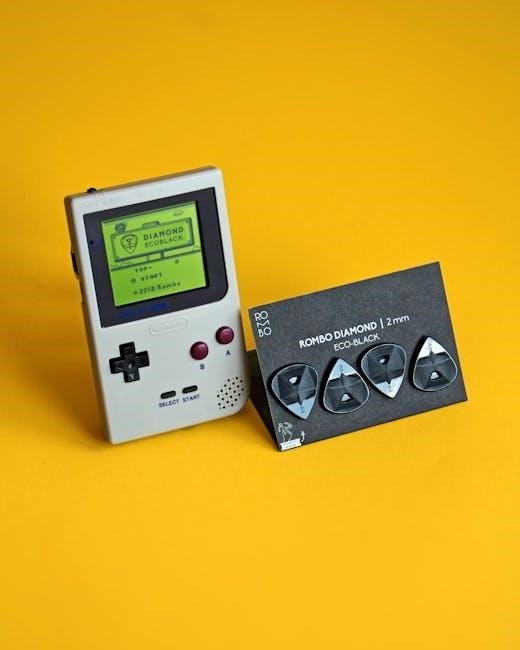Understanding card stock thickness is essential for choosing the right material for your projects. This guide explores weight measurements (GSM and pounds) and caliper thickness in points, helping you select the perfect stock for durability, texture, and aesthetics. Whether crafting greeting cards, scrapbooking, or designing business cards, this guide provides clarity on thickness options to ensure professional and polished results.

Understanding Card Stock Thickness Measurements
Card stock thickness is measured in GSM (grams per square meter) and pounds, while caliper measures thickness in points (1/1000 of an inch). These metrics help determine suitability.
Weight Measurements (Pounds and GSM)
Card stock weight is measured in pounds (lb) and grams per square meter (GSM). GSM measures the weight of a square meter of paper, while pounds measure 500 sheets of uncut paper. Common weights range from 65 lb (176 GSM) to 110 lb (300 GSM). Higher GSM or pounds indicate thicker, heavier paper. For example, 80 lb cover cardstock is 216 GSM, offering mid-weight durability. GSM is a universal standard, making it easier to compare internationally. Understanding these measurements helps select the right card stock for projects requiring specific strength and texture. This ensures your creations, from greeting cards to business cards, have the desired feel and durability.
Caliper (Thickness in Points)
Caliper measures the physical thickness of card stock, expressed in points (pt), where one point equals 1/1000 of an inch. This measurement indicates how rigid or flexible the paper is. Thinner card stocks, like 10 pt, are more pliable, while thicker options, such as 32 pt, offer greater rigidity. Caliper is crucial for projects requiring specific durability, as it directly impacts the paper’s strength and feel. For instance, a 14 pt card stock is ideal for standard applications, while heavier options like 20 pt are better suited for professional-grade business cards or tags. By understanding caliper, you can choose the perfect thickness for your creative or professional needs, ensuring your projects look polished and stand the test of time.

Common Card Stock Weight Options
Card stock weights vary to suit different needs, from lightweight 65 lb (176 gsm) for layering to heavy-duty 100 lb (270 gsm) for professional projects, ensuring versatility and durability.
65 lb Cover Cardstock (176 gsm)
The 65 lb cover cardstock, measuring 176 gsm, is a lightweight yet durable option. It is ideal for layering in scrapbooking, crafting paper flowers, and creating intricate designs. This stock offers a balance between flexibility and sturdiness, making it suitable for projects requiring a delicate touch without compromising on quality. Its moderate thickness ensures it can be easily cut and shaped, while still providing a professional finish. Common uses include greeting cards, invitations, and decorative accents, where a lighter weight is preferred but some rigidity is still needed to maintain the project’s integrity and appearance.
80 lb Cover Cardstock (216 gsm)
The 80 lb cover cardstock, weighing 216 gsm, is a versatile and popular choice for various projects. It offers a sturdy yet flexible texture, making it ideal for greeting cards, invitations, and business cards. This mid-weight option provides excellent durability, resisting bending and ensuring a professional appearance; Its thickness is sufficient for withstanding handling while remaining easy to cut and print on. Many crafters and designers favor this weight for its balance between rigidity and adaptability, making it suitable for both intricate designs and everyday use. Whether for personal or commercial projects, 80 lb cover cardstock delivers a reliable and high-quality finish, ensuring your creations stand out with a premium feel.
100 lb Cover Cardstock (270 gsm)
The 100 lb cover cardstock, measuring 270 gsm, is a heavy-duty option offering exceptional strength and rigidity. It is ideal for projects requiring durability, such as business cards, tags, and scrapbooking layers. This weight provides a premium feel, resisting bending and ensuring a professional appearance. Its thickness makes it perfect for high-end applications where a sturdy material is essential. Crafters and designers often choose this cardstock for its reliability and ability to hold intricate cuts and designs without compromising on quality. Whether for personal or commercial use, 100 lb cover cardstock delivers a robust and long-lasting finish, making it a top choice for projects that demand both style and resilience. Its superior durability ensures your creations remain intact and visually impressive.
How to Choose the Right Card Stock Thickness
Selecting the right card stock thickness involves considering your project’s needs, such as durability, finish, and intended use. Match the weight and caliper to ensure optimal performance and aesthetics for your creations, ensuring they meet both functional and visual expectations.
Understanding GSM vs. Pounds

When selecting card stock, understanding the difference between GSM (grams per square meter) and pounds is crucial. GSM is a global standard measuring paper weight, while pounds are used primarily in the U.S. A higher GSM indicates a heavier and thicker paper, ideal for projects requiring durability. For example, 80 lb cover cardstock is equivalent to 216 GSM, offering a sturdy feel. Conversely, lighter weights like 65 lb (176 GSM) are better for layering or crafts. Knowing these measurements helps in choosing the right thickness for your needs, ensuring your projects are both functional and visually appealing. This guide helps you navigate these standards with ease, making your selection process straightforward and efficient.
Thickness Points and Their Uses
Thickness points measure the physical depth of card stock, expressed in thousandths of an inch. Common points range from 10pt (0.010 inches) to 20pt (0.020 inches). Thicker stocks, like 14pt or 16pt, are ideal for business cards and tags, offering rigidity and a premium feel. Lighter options, such as 10pt, are better for layering or crafts where flexibility is needed. The choice of thickness depends on the project’s requirements, balancing durability with usability. This guide helps you select the optimal point size for your needs, ensuring your creations are both functional and visually appealing. By understanding thickness points, you can achieve professional results in card making, scrapbooking, and more. Always match the thickness to your project’s demands for the best outcome.

Card Stock Thickness for Specific Projects
Choose the right card stock thickness based on your project needs. Greeting cards, scrapbooking, and business cards require different weights for optimal durability and visual appeal. Select wisely for best results.
Greeting Cards and Invitations
Greeting cards and invitations benefit from card stock that balances durability and aesthetics. For casual use, 65 lb (176 gsm) is ideal for layering and lighter designs. Mid-weight 80 lb (216 gsm) is popular for its sturdiness and versatility, making it perfect for most greeting cards and invitations. For formal occasions, 100 lb (270 gsm) offers a premium feel and rigidity, suitable for special events like weddings. Consider finish and texture, as they enhance the card’s appearance. Thicker stocks are better for embellishments, while lighter options are cost-effective. Ensure printer compatibility, as thicker stocks may not work with all devices. Choose wisely to achieve the desired look and functionality.
Business Cards and Tags
When creating professional business cards and tags, selecting the right card stock thickness is crucial. For business cards, 80 lb (216 gsm) or 100 lb (270 gsm) is ideal, offering a sturdy, professional feel. These weights resist bending and ensure longevity, making them perfect for networking. For tags, lighter weights like 65 lb (176 gsm) are often used for a more flexible yet durable option. Thicker stocks, such as 100 lb, provide a premium, high-end appearance. Consider the finish and texture to enhance the design. Smooth finishes are great for readability, while textured options add a unique aesthetic. Ensure the thickness aligns with your printing needs, as thicker stocks may not work with all printers. The right thickness enhances durability and professional appeal, making your business cards and tags stand out.
Scrapbooking and Layering
For scrapbooking and layering, choosing the right card stock thickness is vital to ensure durability and stability. Thicker stocks like 80 lb (216 gsm) or 100 lb (270 gsm) are ideal for base pages, providing a sturdy foundation for heavy embellishments. These weights resist bending and hold up well under layers of paper, photos, and decorations. Lighter weights, such as 65 lb (176 gsm), are great for layering elements like die-cuts or paper flowers, offering flexibility without compromising structure. The thickness ensures your designs remain dimensional and visually appealing. Proper card stock selection enhances the longevity and professional look of your scrapbooking projects, making them treasured keepsakes for years to come.

Factors Influencing Card Stock Choice
Key factors influencing card stock choice include paper finish, durability needs, and cost. These elements ensure the right balance between quality, functionality, and budget for projects.
Paper Finish and Texture
Paper finish and texture play a crucial role in determining the aesthetic and functional aspects of card stock. Common finishes include glossy, silk, satin, and textured options, each offering distinct visual effects. Glossy finishes provide a shiny, reflective surface ideal for vibrant designs, while silk and satin offer a soft, matte appearance that minimizes glare. Textured finishes add a tactile dimension, enhancing the sensory experience of the card stock. Additionally, recycled paper options are available for those prioritizing environmental sustainability. The choice of finish and texture depends on the intended use, with factors like durability, print quality, and visual appeal influencing the decision. Ensuring the right finish and texture can elevate the professionalism and impact of your projects. Always consider these elements to achieve the desired result.
Durability and Rigidity Needs
Durability and rigidity are critical factors when selecting card stock, especially for projects requiring long-lasting results. Thicker card stocks, such as 80 lb (216 gsm) or 100 lb (270 gsm), offer greater resistance to bending and wear, making them ideal for business cards, tags, and professional presentations. For scrapbooking, a sturdy base layer ensures stability when adding layers or embellishments; Heavier card stocks provide a premium feel and are less prone to damage, while lighter options may be sufficient for projects where flexibility is more important. Assessing the intended use and required longevity helps determine the appropriate thickness and weight for optimal performance and appearance. Balancing durability with practicality ensures your projects stand the test of time and use.
Cost and Availability
Cost and availability are significant considerations when selecting card stock. Thicker, heavier card stocks like 100 lb (270 gsm) or 80 lb (216 gsm) are generally more expensive than lighter options, such as 65 lb (176 gsm). Budget-friendly options are ideal for personal projects, while premium card stocks may be worth the investment for professional or high-end applications. Availability also plays a role, as lighter weights are commonly found in retail stores, while heavier or specialty card stocks may require online orders or visits to craft stores. Balancing cost with project requirements ensures you achieve the desired quality without overspending. Additionally, bulk purchasing can often reduce costs for frequent users, making it a practical choice for businesses or avid crafters.
Selecting the right card stock thickness is crucial for achieving the desired outcome in various projects. By understanding weight measurements, such as GSM and pounds, and thickness in points, you can make informed decisions. Whether creating greeting cards, business cards, or scrapbook layers, the right thickness ensures durability, texture, and aesthetic appeal. Balancing cost, availability, and project requirements helps optimize your selections. This guide has provided a comprehensive overview to assist in choosing the perfect card stock for any application, ensuring your creations are both functional and visually impressive.